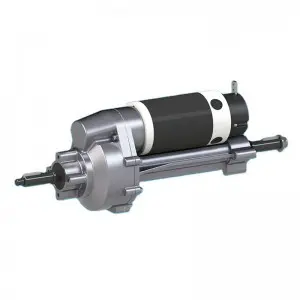The Chevrolet Corvette is an iconic American sports car that has captured the hearts of car enthusiasts since its introduction in 1953. Known for its stylish design, powerful performance and innovative engineering, the Corvette has undergone numerous transformations over the decades. One of the most significant changes in its engineering design was the introduction of a transaxle system. This article explores the history of the Corvette and delves into when it began using a transaxle and the impact of this engineering choice.
Understand the transaxle
Before we dive into the history of the Corvette, it’s necessary to understand what a transaxle is. A transaxle combines the transmission, axle and differential into a single unit. This design allows for a more compact layout, which is particularly beneficial in sports cars where weight distribution and balance are critical to performance. The transaxle system allows for better handling, improved weight distribution and a lower center of gravity, all of which contribute to enhanced driving dynamics.
Corvette’s Early Years
The Corvette made its debut at the 1953 New York Auto Show and released its first production model later that year. Initially, the Corvette came with a traditional front-engine, rear-wheel-drive layout paired with a three-speed manual transmission. This setup was standard on most cars at the time, but it limited the Corvette’s performance potential.
As the popularity of the Corvette grew, Chevrolet began exploring ways to improve its performance. The introduction of the V8 engine in 1955 marked a major turning point, giving the Corvette the power it needed to compete with European sports cars. However, a traditional gearbox and rear axle setup still presents challenges in terms of weight distribution and handling.
Steering Transaxle: C4 Generation
Corvette’s first foray into transaxles came with the introduction of the 1984 C4 generation. The model marks a departure from previous generations, which relied on a conventional gearbox and rear axle configuration. The C4 Corvette was designed with performance in mind, and the transaxle system plays a vital role in achieving that goal.
The C4 Corvette uses a rear-mounted transaxle to provide a more balanced weight distribution between the front and rear of the vehicle. This design not only improves handling, it also helps lower the center of gravity and enhances the car’s overall stability when maneuvering at high speeds. The C4’s transaxle paired with the powerful 5.7-liter V8 engine provides an exciting driving experience and cements the Corvette’s reputation as a world-class sports car.
Impact of Transaxle on Performance
The introduction of the transaxle in the C4 Corvette had a profound impact on the car’s performance characteristics. With more even weight distribution, the C4 exhibits improved cornering capabilities and reduced body roll. This makes the Corvette even more agile and responsive, allowing the driver to navigate tight corners with confidence.
In addition, the transaxle system also incorporates advanced technologies such as anti-lock braking and traction control to further improve the car’s performance and safety. The C4 Corvette became a fan favorite and was even used in various racing competitions to show off its prowess on the track.
The evolution continues: C5 and above
The success of the C4-generation transaxle system paved the way for its continued use in subsequent Corvette models. Introduced in 1997, the C5 Corvette builds on its predecessor. It features a more refined transaxle design that helps improve performance, fuel efficiency and the overall driving experience.
The C5 Corvette is equipped with a 5.7-liter LS1 V8 engine that produces 345 horsepower. The transaxle system allows for better weight distribution, resulting in enhanced acceleration and cornering capabilities. The C5 also introduces a more modern design with a focus on aerodynamics and comfort, making it a well-rounded sports car.
As the Corvette continues to evolve, the transaxle system remains a key component in the C6 and C7 generations. Each iteration brought advancements in technology, performance and design, but the fundamental advantages of the transaxle remained intact. The 2005 C6 Corvette featured a more powerful 6.0-liter V8, while the 2014 C7 showcased a 6.2-liter LT1 V8, further cementing the Corvette’s status as a performance icon.
Mid-Engine Revolution: C8 Corvette
In 2020, Chevrolet launched the C8 Corvette, which marked a significant shift from the traditional front-engine layout that had defined the Corvette for decades. The C8’s mid-engine design required a complete rethinking of the transaxle system. The new layout enables better weight distribution and handling characteristics, pushing the boundaries of performance.
The C8 Corvette is powered by a 6.2-liter LT2 V8 engine that produces an impressive 495 horsepower. The transaxle system in the C8 is designed to optimize performance, focusing on delivering power to the rear wheels while maintaining balance and stability. This innovative design has won widespread acclaim, making the C8 Corvette a formidable competitor in the sports car market.
in conclusion
The introduction of the transaxle system in the Corvette marked a pivotal moment in the car’s history, resulting in improved performance, handling and the overall driving experience. Beginning with the C4 generation in 1984, the transaxle has been an integral part of the Corvette’s engineering, establishing it as the iconic American sports car.
As the Corvette continues to evolve, the transaxle system remains a key component in its design, allowing Chevrolet to push the boundaries of performance and innovation. From the early Corvette to the modern mid-engine C8, the transaxle has played a vital role in shaping automotive heritage and securing its place in automotive history. Whether you’re a long-time Corvette enthusiast or new to the world of sports cars, the transaxle’s impact on the Corvette is undeniable, and its story is far from over.
Post time: Oct-14-2024


